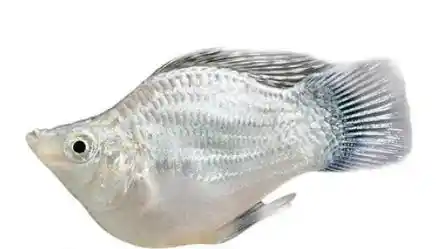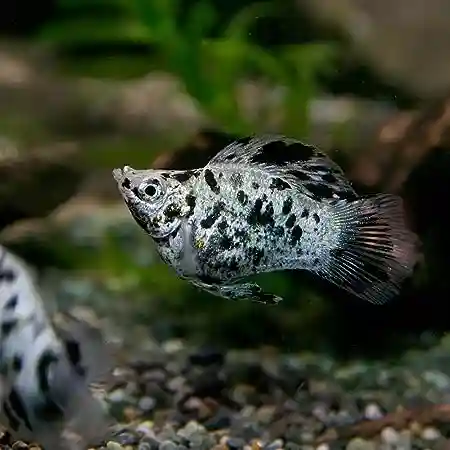Welcome to the fascinating world of the balloon molly! These delightful fish are a favorite among aquarium enthusiasts for their vibrant colors, distinct appearance, and ease of care. In this comprehensive article, we’ll dive into the wonderful realm of the balloon molly, exploring everything from their origins and characteristics to essential care tips and frequently asked questions. Whether you’re a beginner or an experienced aquarist, you’ll find valuable insights to ensure the well-being of your balloon mollies.
The Balloon Mollies: A Colorful Marvel
The balloon molly (Poecilia latipinna) is a tempting freshwater fish known for its distinctive appearance. Its rounded, balloon-like body shape sets it apart from other mollies, making it a unique and attractive addition to any aquarium. These fish come in a wide range of striking colors, including vibrant orange, velvety black, and shimmering silver.
Balloon Molly: The History and Origin
Native to the warm, brackish waters of the Gulf of Mexico and the Atlantic coast of North America, balloon mollies have become a popular choice for aquarium enthusiasts around the world. They were first introduced to the aquarium trade in the mid-20th century, and their popularity has only grown since then.

- Native Habitat: Balloon mollies (Poecilia latipinna) are native to the Gulf of Mexico and the Atlantic coast of North America. They inhabit warm, brackish waters in these regions.
- Discovery: The species was first discovered in these coastal waters, where they adapted to a diverse environment with varying salinity levels due to the proximity to the ocean.
- Aquarium Introduction: Balloon mollies gained popularity in the aquarium trade during the mid-20th century due to their unique appearance and lively behavior. Their distinct “balloon-like” body shape intrigued aquarium enthusiasts.
- Selective Breeding: Over time, selective breeding led to the development of the balloon variety, which features the distinctive rounded body shape that sets them apart from other mollies.
- Global Appeal: The charming and vibrant nature of balloon mollies quickly captured the attention of fishkeepers worldwide, making them a sought-after addition to community tanks.
- Adaptability: Balloon mollies’ adaptability to different water conditions, including both freshwater and slightly brackish environments, contributed to their popularity and widespread distribution.
- Conservation: Although popular in the aquarium trade, it’s essential to remember that these fish are originally from specific regions. Efforts have been made to raise awareness about responsible aquarium keeping to protect their natural habitats.
- Continued Popularity: Balloon mollies continue to be a popular choice among beginners and experienced aquarists, thanks to their appealing colors, unique body shape, and relatively straightforward care requirements.
The Balloon Molly’s Unique Characteristics
Balloon mollies possess several distinct features that make them stand out among other fish species:
- Color Varieties: As mentioned earlier, these fish come in various vibrant colors, allowing you to create a visually stunning aquarium.
- Balloon-Like Body: The rounded body shape, from which they get their name, is not only charming but also adds a touch of uniqueness to your tank.
- Livebearing: Balloon mollies are livebearers, which means they give birth to live fry instead of laying eggs. This behavior makes them intriguing to observe during the birthing process.
- Community-Friendly: Balloon mollies are generally peaceful and can thrive in community tanks with other compatible fish species.
Various Types of Balloon Mollies
White Balloon Molly: Sporting a clean white coloration, these mollies stand out in aquariums.
Black Lyretail Balloon Molly: Their unique feature is a black lyretail, adding elegance to their appearance.
Black Mottled Lyretail Balloon Molly: Similar to the black lyretail, but with mottled patterns for added intrigue.
Red Dalmation Balloon Molly: With red spots against a lighter body, they resemble the Dalmatian dog’s markings.
Black Balloon Molly: These have a bold black coloration, creating a striking contrast in tanks.
Golden Balloon Molly: Sporting a vibrant golden hue, these mollies shimmer in aquariums.
Dalmation Balloon Molly: With black spots on a lighter body, they resemble the spots of a Dalmatian dog.
Golden Lyretail Balloon Molly: Combining a golden body with a lyretail, these mollies exude elegance.
White Lyretail Balloon Molly: Their distinguishing feature is a white coloration coupled with a lyretail.
Gold Calico Balloon Molly: Showcasing a blend of gold, white, and other colors, they exhibit a calico-like pattern.
These variations offer a diverse range of colors and patterns for aquarium enthusiasts!
Setting Up the Perfect Mollies Home: Aquarium Requirements
To provide the best care for your balloon mollies, it’s essential to create a suitable environment in your aquarium. Here’s what you need to consider:
- Tank Size: A 20-gallon tank or larger is recommended for a small group of balloon mollies. The extra space allows them to swim freely and reduces territorial disputes.
- Water Parameters: Balloon mollies prefer slightly brackish water with a temperature range of 75–82°F (24–28°C) and a pH level between 7.5 and 8.5. Regular water changes are crucial to maintaining optimal water quality.
- Decor and Substrate: Provide ample hiding spots and use a substrate that mimics their natural habitat. Live plants, smooth rocks, and driftwood are great additions.
- Filtration and Aeration: A reliable filter and proper aeration are essential to keep the water clean and oxygenated.
A Balanced Diet: Feeding Your Balloon Mollies
Balloon mollies are omnivorous, meaning they consume both plant matter and small invertebrates. A balanced diet is crucial for their health and vitality.
- High-Quality Flake Food: A staple diet of high-quality flake food formulated for tropical fish provides essential nutrients.
- Variety: Supplement their diet with live or frozen foods such as brine shrimp, daphnia, and vegetable matter like blanched spinach or peas.
Balloon Mollies pregnant care
Balloon mollies, like other live-bearing fish, exhibit fascinating reproductive behavior. When a female balloon molly becomes pregnant, she carries developing fry (baby fish) in her body until they are ready to be born. Taking care of pregnant balloon mollies is crucial to ensure the health and survival of both the mother and her offspring. Here’s a comprehensive guide on how to provide proper care for balloon mollies during pregnancy:

- Identifying Pregnancy: Balloon mollies are known for their rounded bellies, especially when they are pregnant. A pregnant female’s abdomen becomes noticeably swollen as the fry develops inside her. This is the most obvious sign of pregnancy.
- Separate Breeding Tank: It’s a good idea to have a separate breeding tank prepared for pregnant balloon mollies. This tank should be equipped with fine-leaved plants, a breeding trap, or other hiding spots where the fry can seek refuge once born. This prevents the adult fish from consuming the fry, as mollies are known to eat their own young if not provided with proper hiding places.
- Maintaining Water Quality: Proper water quality is essential during pregnancy. Ensure that the water parameters, such as temperature, pH, and ammonia levels, are stable and suitable for the species. Regular water changes help maintain a clean and healthy environment for pregnant mollies and their fry.
- Nutrition: Providing a well-balanced diet is crucial for the health of both the pregnant female and the developing fry. A diet rich in protein and essential nutrients supports healthy fry development. Offer a combination of high-quality flake food, live or frozen foods (such as brine shrimp or daphnia), and vegetable matter (such as blanched spinach or peas).
- Monitor Stress: Pregnant balloon mollies can be sensitive to stress. Minimize disturbances in the tank, and avoid handling the pregnant female excessively. A calm and stress-free environment contributes to successful pregnancy and birthing.
- Observation: Keep a close eye on pregnant Molly as her due date approaches. Once she’s ready to give birth, you may notice her seeking out the hiding spots you’ve provided in the breeding tank. Balloon mollies usually give birth during the night or early morning.
- After Birth Care: After the female has given birth, it’s essential to promptly remove her from the breeding tank to prevent any potential harm to the fry. The fry is generally capable of swimming and finding hiding spots on their own. Be prepared to feed them with finely crushed flake food or specialized fry food once they start swimming freely.
By following these care guidelines, you can create a safe and nurturing environment for your pregnant balloon mollies and their adorable fry. Balloon molly breeding can be a rewarding experience, allowing you to witness the miracle of life as the tiny fry grow and thrive in your aquarium.
Breeding Balloon Mollies: A Delightful Experience
Breeding balloon mollies can be a rewarding endeavor, especially for those interested in observing the fascinating reproductive behavior of livebearers.
- Separate Breeding Tank: Prepare a separate breeding tank with fine-leaved plants or a breeding trap to protect the fry.
- Monitoring and Care: Once the female gives birth, move her back to the main tank to prevent any potential stress or harm from other fish. Provide ample hiding spots for the fry in the breeding tank.
Common Health Concerns and How to Address Them
Ensuring the health of your balloon mollies is essential. Here are some common health concerns and ways to address them:
- Ich (White Spot Disease): This parasitic infection manifests as small white spots on the fish’s body. Quarantine the affected fish and treat the tank with suitable medication.
- Fin Rot: Poor water quality and stress can lead to fin rot. Maintain a clean tank, and if necessary, treat affected fish with antibiotics.
Bacterial Fish Infections
- API FIN & BODY CURE Freshwater Fish Powder Medication: This treats various fish health issues like body slime, cloudy eyes, fin and tail rot, open red sores, gill disease, and hemorrhagic septicemia.
Conclusion
Balloon mollies make a great addition to aquariums—they add color, charm, and something special. If you learn how to take care of them, you can make a happy place for these lovely fish. Whether you’re new to fishkeeping or a pro, balloon mollies are a must-have fish.
Frequently Asked Questions (FAQs)
Can balloon mollies live in freshwater-only tanks?
Yes, they can adapt to freshwater tanks, but they may thrive better in slightly brackish water.
How many balloon mollies should I keep in my aquarium?
A small group of 3-4 mollies is a good starting point. Ensure a balanced male-to-female ratio to prevent excessive harassment.
Are balloon mollies suitable for beginners?
Yes, their hardy nature and relatively easy care requirements make them suitable for beginners.
Do balloon mollies require a heater in their tank?
Yes, a heater is essential to maintain the proper temperature range for their well-being.
Can I keep balloon mollies with aggressive fish species?
It’s best to avoid aggressive tankmates, as balloon mollies are peaceful and may become targets for aggression.
How often should I feed my balloon mollies?
Feed them small portions 2-3 times a day, and monitor their feeding habits to prevent overfeeding.
Disclaimer
“As an Amazon Associate, we earn from qualifying purchases where there is no additional cost to you. This is one way to support us.” The products displayed here are well-researched, highly rated by users, and fast-moving.












